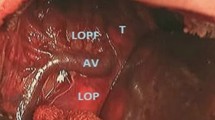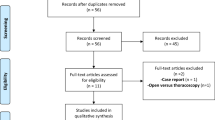Abstract
The aim of this study is to report a series of patients with the Azygos vein preserved during the surgery for esophageal atresia with tracheoesophageal fistula (EA&TEF), highlighting the advantages in terms of survival and prevention of anastomotic leak. Ninety-six neonates with EA&TEF, admitted to the Department of Pediatric Surgery, King George Medical University between 2004 and 2006, were reviewed prospectively; the babies were randomly allocated to two groups: Group A (n = 46) in which the Azygos vein was preserved and Group B (n = 50), wherein it was ligated. The two groups were comparable in respect to sex, weight, prematurity, associated anomalies, Waterston classification, Spitz classification and distance between the pouches after mobilization. Anastomotic leak occurred in three cases (6%) in Group A and ten cases (20%) in Group B and was responsible for mortality in one (2%) case in Group A and six cases (12%) in Group B. Preservation of Azygos vein resulted in significant reduction in the number of anastomotic leaks. We propose that preservation of the Azygos vein prevents early postoperative edema of the esophageal anastomosis by maintaining the venous drainage and thus may form an additional protective factor against anastomotic leaks.



Similar content being viewed by others
References
Myers NA (1974) Oesophageal atresia: the epitome of modern surgery. Ann R Coll Surg Engl 54:277–287
Konkin DE, O’hali WA, Webber EM, Blair GK (2003) Outcomes in esophageal atresia and tracheoesophageal fistula. J Pediatr Surg 38:1726–1729
Gabella G (2000) Veins of the thorax. In: Williams PI (ed) Gray’s anatomy: the anatomical basis of medicine and surgery. Churchill Livingstone, London, pp 1593
Holder TM (1993) Esophageal atresia and tracheoesophageal malformations. In: Ashcraft KW, Holder TM (eds) Pediatric surgery. W.B. Saunders, Philadelphia, pp 249–269
McKinnon LJ, Kosloske AM (1990) Prediction and prevention of anastomotic complications of esophageal atresia and tracheo-esophageal fistula. J Pediatr Surg 25:778–816
Chittmittrapap S, Spitz L, Brereton RJ et al (1992) Anastomotic leakage following surgery for esophageal atresia. J Pediatr Surg 27:29–32
Sarin YK, Nambirajan L (1996) Anastomotic leakage following repair of esophageal atresia and tracheo-esophageal fistula. Indian J Pediatr Surg 1:83–85
Author information
Authors and Affiliations
Corresponding author
Rights and permissions
About this article
Cite this article
Sharma, S., Sinha, S.K., Rawat, J.D. et al. Azygos vein preservation in primary repair of esophageal atresia with tracheoesophageal fistula. Pediatr Surg Int 23, 1215–1218 (2007). https://doi.org/10.1007/s00383-007-2008-5
Accepted:
Published:
Issue Date:
DOI: https://doi.org/10.1007/s00383-007-2008-5




